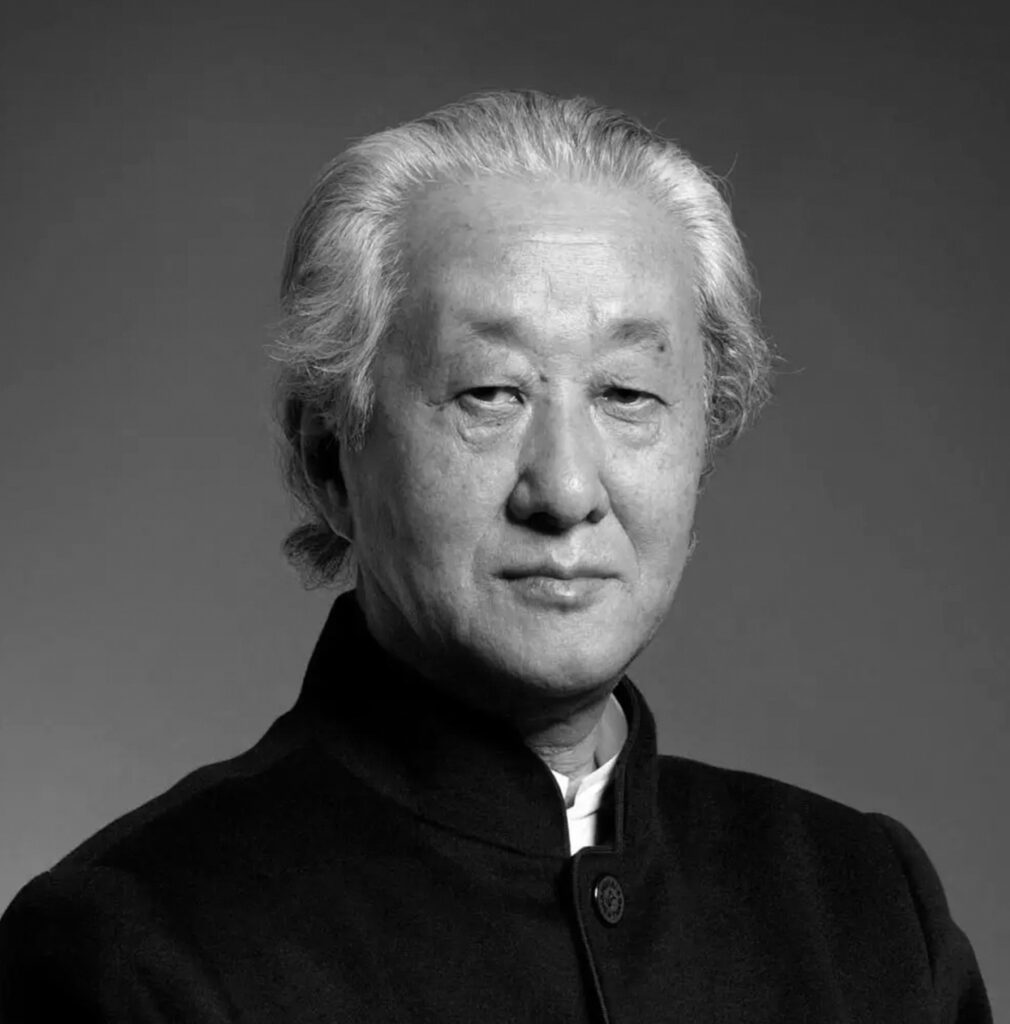ARATA ISOZAKI
One of the most significant figures in contemporary Japanese Architecture, Arata Isozaki, was born in 1931 in Oita, Japan. He was an architect, urban designer, and architectural philosopher. He studied architecture at the University of Tokyo and worked with Professor Kenzo Tange on several significant projects until 1963. The Tokyo Plan (1960) and the significant Osaka Expo ’70 pavilion were two of these designs. As Tange’s heir, Isozaki eventually became well-known in the world of architecture.
In the late 1960s, Isozaki gained fame for his work, where he designed several notable buildings, namely the Iwata High School, the Nakayama Residence (1964), the Oita Prefectural Library, and the Fukuoka City Bank branch. In 1990, he designed Yufuin Station, followed by B-con Plaza, and the new Oita Prefectural Library in 1995. In 1968, the global student revolution had an impact on him and led him to re-evaluate his architectural philosophies. Isozaki developed theories on architectural form throughout his private years. These theories were transformed into intricate geometric works, some of which had monolithic volumes and others that included intricate combinations of primary volumes, but they were always colossal in nature.
His favorite architectural era was the Renaissance in Western architecture, and he used aspects of Neoclassicism and Renaissance Western architecture to design...
One of the most significant figures in contemporary Japanese Architecture, Arata Isozaki, was born in 1931 in Oita, Japan. He was an architect, urban designer, and architectural philosopher. He studied architecture at the University of Tokyo and worked with Professor Kenzo Tange on several significant projects until 1963. The Tokyo Plan (1960) and the significant Osaka Expo ’70 pavilion were two of these designs. As Tange’s heir, Isozaki eventually became well-known in the world of architecture.
In the late 1960s, Isozaki gained fame for his work, where he designed several notable buildings, namely the Iwata High School, the Nakayama Residence (1964), the Oita Prefectural Library, and the Fukuoka City Bank branch. In 1990, he designed Yufuin Station, followed by B-con Plaza, and the new Oita Prefectural Library in 1995. In 1968, the global student revolution had an impact on him and led him to re-evaluate his architectural philosophies. Isozaki developed theories on architectural form throughout his private years. These theories were transformed into intricate geometric works, some of which had monolithic volumes and others that included intricate combinations of primary volumes, but they were always colossal in nature.
His favorite architectural era was the Renaissance in Western architecture, and he used aspects of Neoclassicism and Renaissance Western architecture to design the Tsukuba Centre building in 1983, featuring a replica of Michelangelo’s plan for Rome as well as a statue of Marcus Aurelius. Isozaki’s first abroad project was held by the Contemporary Museum of Art in Los Angeles in 1986, labeled “a beacon in the land of the lost.”
Isozaki tried to draw his identity from a Japanese feeling of place with the Mito Art Tower (1990) following the development of the Tsukuba Centre. This tower represents the clash between students and the security forces in the late 1960s. When he was chosen to build the Sant Jordi Sports Hall in Spain for the 1990 Olympics, he attracted attention from all around the world. He completed the construction of the Team Disney Building in Orlando, Florida, the following year. Isozaki’s architectural style changed in the 1990s, becoming more fluid and free-form, with structures that had oval, hyperbolic, and parabolic shapes. His references to the past vanished as postmodern architecture became more and more fashionable. His love of abstract composition was on display in 1998 at the Shizuoka Prefectural Convention and Art Centre as well as the Nara Convention Hall.
Kenzo Tange and the Metabolists inspired Isozaki’s love of mechanical gadgets, but he favored a more abrasive method. He has won a number of awards and held honorary memberships in the American Institute of Architects, Bund Deutscher Architekten, and Knight of the Order of Arts and Letters; in 2019, Isozaki also received the prestigious Pritzker Prize.

ARATA ISOZAKI
One of the most significant figures in contemporary Japanese Architecture, Arata Isozaki, was born in 1931 in Oita, Japan. He was an architect, urban designer, and architectural philosopher. He studied architecture at the University of Tokyo and worked with Professor Kenzo Tange on several significant projects until...
One of the most significant figures in contemporary Japanese Architecture, Arata Isozaki, was born in 1931 in Oita, Japan. He was an architect, urban designer, and architectural philosopher. He studied architecture at the University of Tokyo and worked with Professor Kenzo Tange on several significant projects until 1963. The Tokyo Plan (1960) and the significant Osaka Expo ’70 pavilion were two of these designs. As Tange’s heir, Isozaki eventually became well-known in the world of architecture.
In the late 1960s, Isozaki gained fame for his work, where he designed several notable buildings, namely the Iwata High School, the Nakayama Residence (1964), the Oita Prefectural Library, and the Fukuoka City Bank branch. In 1990, he designed Yufuin Station, followed by B-con Plaza, and the new Oita Prefectural Library in 1995. In 1968, the global student revolution had an impact on him and led him to re-evaluate his architectural philosophies. Isozaki developed theories on architectural form throughout his private years. These theories were transformed into intricate geometric works, some of which had monolithic volumes and others that included intricate combinations of primary volumes, but they were always colossal in nature.
His favorite architectural era was the Renaissance in Western architecture, and he used aspects of Neoclassicism and Renaissance Western architecture to design the Tsukuba Centre building in 1983, featuring a replica of Michelangelo’s plan for Rome as well as a statue of Marcus Aurelius. Isozaki’s first abroad project was held by the Contemporary Museum of Art in Los Angeles in 1986, labeled “a beacon in the land of the lost.”
Isozaki tried to draw his identity from a Japanese feeling of place with the Mito Art Tower (1990) following the development of the Tsukuba Centre. This tower represents the clash between students and the security forces in the late 1960s. When he was chosen to build the Sant Jordi Sports Hall in Spain for the 1990 Olympics, he attracted attention from all around the world. He completed the construction of the Team Disney Building in Orlando, Florida, the following year. Isozaki’s architectural style changed in the 1990s, becoming more fluid and free-form, with structures that had oval, hyperbolic, and parabolic shapes. His references to the past vanished as postmodern architecture became more and more fashionable. His love of abstract composition was on display in 1998 at the Shizuoka Prefectural Convention and Art Centre as well as the Nara Convention Hall.
Kenzo Tange and the Metabolists inspired Isozaki’s love of mechanical gadgets, but he favored a more abrasive method. He has won a number of awards and held honorary memberships in the American Institute of Architects, Bund Deutscher Architekten, and Knight of the Order of Arts and Letters; in 2019, Isozaki also received the prestigious Pritzker Prize.

ARATA ISOZAKI
One of the most significant figures in contemporary Japanese Architecture, Arata Isozaki, was born in 1931 in Oita, Japan. He was an architect, urban designer, and architectural philosopher. He studied architecture at the University of Tokyo and worked with Professor Kenzo Tange on several significant projects until 1963. The Tokyo Plan (1960) and the significant Osaka Expo ’70 pavilion were two of these designs. As Tange’s heir, Isozaki eventually became well-known in the world of architecture.
In the late 1960s, Isozaki gained fame for his work, where he designed several notable buildings, namely the Iwata High School, the Nakayama Residence (1964), the Oita Prefectural Library, and the Fukuoka City Bank branch. In 1990, he designed Yufuin Station, followed by B-con Plaza, and the new Oita Prefectural Library in 1995. In 1968, the global student revolution had an impact on him and led him to re-evaluate his architectural philosophies. Isozaki developed theories on architectural form throughout his private years. These theories were transformed into intricate geometric works, some of which had monolithic volumes and others that included intricate combinations of primary volumes, but they were always colossal in nature.
His favorite architectural era was the Renaissance in Western architecture, and he used aspects of Neoclassicism and Renaissance Western architecture to design the Tsukuba Centre building in 1983, featuring a replica of Michelangelo’s plan for Rome as well as a statue of Marcus Aurelius. Isozaki’s first abroad project was held by the Contemporary Museum of Art in Los Angeles in 1986, labeled “a beacon in the land of the lost.”
Isozaki tried to draw his identity from a Japanese feeling of place with the Mito Art Tower (1990) following the development of the Tsukuba Centre. This tower represents the clash between students and the security forces in the late 1960s. When he was chosen to build the Sant Jordi Sports Hall in Spain for the 1990 Olympics, he attracted attention from all around the world. He completed the construction of the Team Disney Building in Orlando, Florida, the following year. Isozaki’s architectural style changed in the 1990s, becoming more fluid and free-form, with structures that had oval, hyperbolic, and parabolic shapes. His references to the past vanished as postmodern architecture became more and more fashionable. His love of abstract composition was on display in 1998 at the Shizuoka Prefectural Convention and Art Centre as well as the Nara Convention Hall.
Kenzo Tange and the Metabolists inspired Isozaki’s love of mechanical gadgets, but he favored a more abrasive method. He has won a number of awards and held honorary memberships in the American Institute of Architects, Bund Deutscher Architekten, and Knight of the Order of Arts and Letters; in 2019, Isozaki also received the prestigious Pritzker Prize.
ARTWORK
ARTWORK
ARTWORK



